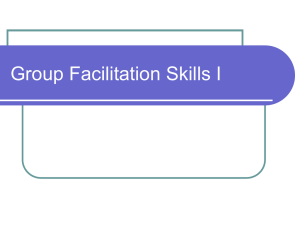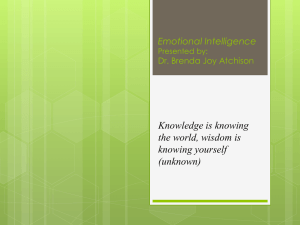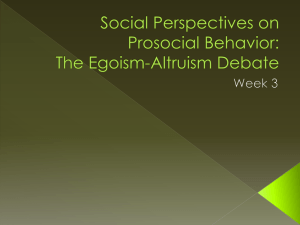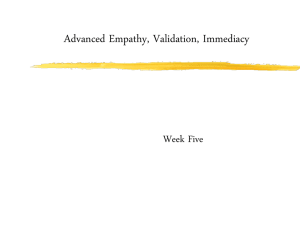The Importance of Empathy
advertisement
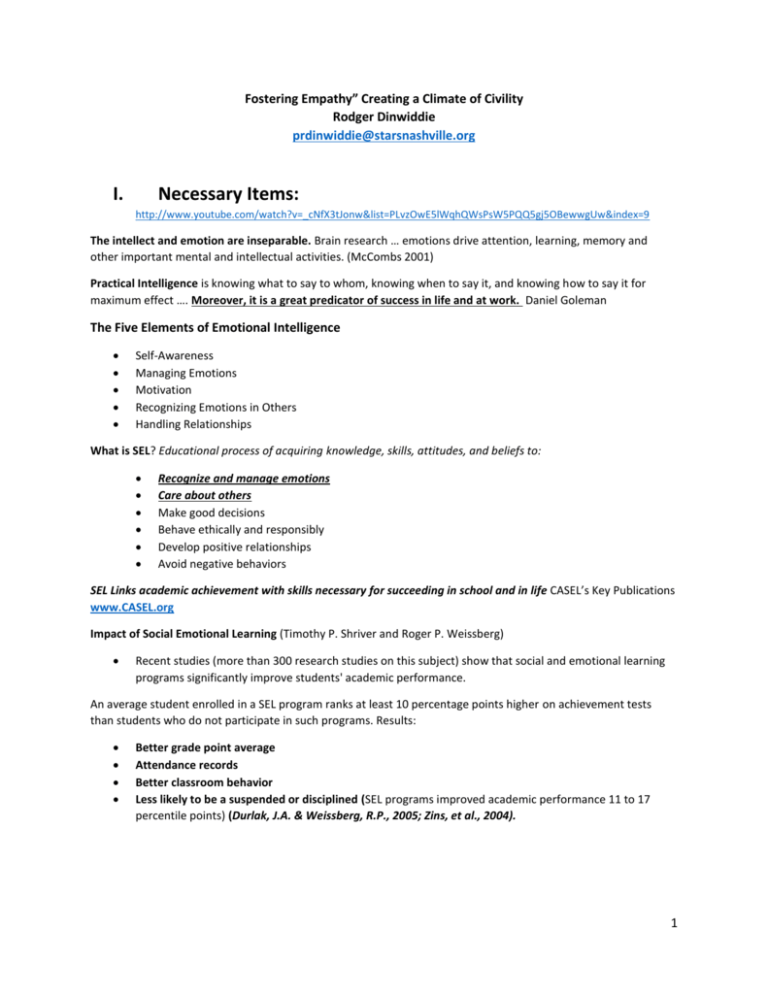
Fostering Empathy” Creating a Climate of Civility Rodger Dinwiddie prdinwiddie@starsnashville.org I. Necessary Items: http://www.youtube.com/watch?v=_cNfX3tJonw&list=PLvzOwE5lWqhQWsPsW5PQQ5gj5OBewwgUw&index=9 The intellect and emotion are inseparable. Brain research … emotions drive attention, learning, memory and other important mental and intellectual activities. (McCombs 2001) Practical Intelligence is knowing what to say to whom, knowing when to say it, and knowing how to say it for maximum effect …. Moreover, it is a great predicator of success in life and at work. Daniel Goleman The Five Elements of Emotional Intelligence Self-Awareness Managing Emotions Motivation Recognizing Emotions in Others Handling Relationships What is SEL? Educational process of acquiring knowledge, skills, attitudes, and beliefs to: Recognize and manage emotions Care about others Make good decisions Behave ethically and responsibly Develop positive relationships Avoid negative behaviors SEL Links academic achievement with skills necessary for succeeding in school and in life CASEL’s Key Publications www.CASEL.org Impact of Social Emotional Learning (Timothy P. Shriver and Roger P. Weissberg) Recent studies (more than 300 research studies on this subject) show that social and emotional learning programs significantly improve students' academic performance. An average student enrolled in a SEL program ranks at least 10 percentage points higher on achievement tests than students who do not participate in such programs. Results: Better grade point average Attendance records Better classroom behavior Less likely to be a suspended or disciplined (SEL programs improved academic performance 11 to 17 percentile points) (Durlak, J.A. & Weissberg, R.P., 2005; Zins, et al., 2004). 1 Developing Resilience: Problem solving skills, Autonomy, Social competence (Building Empathy and Caring), Sense of purpose and future Characteristics of Individuals with High EQ I. Knowledge of their emotions … as they occur Managing emotions … applying the knowledge Motivating oneself to care about others’ emotions … in relationships Recognizing the emotions of others Handling relationships – managing emotions in others The Importance of Empathy Definitions of empathy The capacity to think and feel oneself into the inner life of another person. (Kohut) Spontaneously and naturally tuning into the other person’s thoughts and feelings, whatever these might be. (Baron-Cohen) What happens to us when we leave our own bodies … and find ourselves either momentarily or for a longer period of time in the mind of the other. We observe reality through their eyes, feel their emotions, and share in their pain. (Lambert) Empathy is the ability to vicariously feel what another person is feeling, to understand and connect to where that person is. Empathy is a social skill, and as such it can be taught, practices, and applied. (Goldstein, 1999) Two Kinds of Empathy: Emotional Empathy or affective empathy: The desire to respond with an appropriate emotion to another’s mental states. Cognitive Empathy: The desire to identify another's mental states. 10 Traits of Successful Workers: “The attitude of a qualified employee is the single most important criteria we use when evaluating job candidates.” Denise Keller, COO, Benchmark EMAIL. Focused, Creative, Humble, Observant, Optimistic, Ambitious, Eager to Learn, Approachable, Enthusiastic, Well rounded ***Wired to Care, Dev Patnaik, 2009 Empathy Comes Naturally When children see other in pain, their brains respond as if it were happening to them. Same response also shown in adults. Normal school-age children may be naturally prone to empathy. There is an inborn capacity to resonate with the pain of others. Jean Decety, University of Chicago Prosocial behaviors emerge by the second year of life … they increase during the toddler years. Aggressive Tendencies are pretty much a done deal by age 2.” (Physical Aggression.) Development of empathy occurs by age 2. Empathy is crystallized by age 9 2 The Empathy Gap “People fail to understand the consequences of the social trauma experienced by victims of bullying, teasing and ostracism.” “This empathy gap can be devastating because it means victims often do not get the support, intervention or advocacy they need.” Everyone knows that social trauma is unpleasant, but people are often blind to the full severity of these experiences and therefore don’t do enough to protect or intervene when victims suffer.” Physical pain and intense feeling of social rejection “hurt” in the same way, a new study shows. The same regions of the brain that became active in response to painful sensory experiences are activated during intense experiences of social rejection. These results give new meaning to the idea that social rejection “hurts.” Ethan Kross, University of Michigan, Proceedings of the National Academy of Sciences. Keys to Empathy Put yourself in the others’ shoes Pay attention to what the person is feeling. Listen to the person’s words and tone of voice. Pay attention to body language Pay attention to your own feelings as you observe Put these feelings into words, keeping the focus on the other person Keep it simple and use your own words Avoid repeating exactly what the other person has said. Doing this will likely annoy … which is not empathetic. Give the person a chance to respond to your comments. Do not worry about getting it exactly right … the important thing is to listen and pay close attention and show you understand. Empathy is the ability to mutually experience the thoughts, emotions, and direct experiences of others. It goes beyond sympathy which is a feeling of care and understanding for the suffering of others. Exercises to Teaching Listening with Empathy www.ehow.com/info_8146254_activities-listenempathy.html#ixzz2lctvvpw6 (Also games, activities, etc.) “Only by having a heightened sense of empathy to victim's true suffering can we begin to pave the way for reform and new policies.” Only when students, teachers and administrators partake in exercises that simulate a socially painful event, such as bullying, can they be truly empathetic to its consequences.” Our perception of social pain matters as much as our understanding of physical pain. Not only do estimates of social pain govern how we empathize with socially traumatic events, but they guide our approach to how well we advocate on a victims’ behalf. Loran Nordgren, Kasia Banas, Geoff MacDonald When Principals go “all in” in terms of supporting Social Emotional Learning Programs, school programs, teachers stand a better chance of successfully implementing change.” If school principals lack enthusiasm or show little support, they are actually viewed as a hindrance by teachers, posing “major challenges” to the success of schools programs. Apprehensive teachers are more willing to try new approaches in their classrooms if they know they have the support of the administration. ( University of Pittsburg and University of Virginia) 3 II. What to Do? The School of Belonging – David Levine 1. 2. 3. 4. Caring intentions on the part of all staff members SEL needs of all students are honored Any form of emotional violence is entirely unacceptable Staff and students participate in regular focus groups. This keeps staff in touch with the emotional dynamics of the school … provides for collaboration Cultural literacy initiatives are coordinated in concert with SEL initiatives. (Diversity and empathy trainings, etc.) 5. The Ten Intentions … of a School of Belonging – David Levine 1. 2. 3. 4. 5. 6. 7. 8. 9. 10. Practicing The presence of a supportive leader Effective SEL in-service training An inviting school office Assembly programs/student workshops Mentor programs for staff and students Monthly grade level community meetings Daily celebration and recognition of students A variety of extracurricular activities for all students Alternative programming Parent workshops What happened? (the event) How is that person feeling? (empathy) What will I do? (a specific action) Use hypothetical situations/scenarios a class can discuss in order to explore options for empathic responses: A new student just arrived today and sitting is alone in the cafeteria. A classmate just found out that her family has to move because her mom’s job has been transferred. At the foundation of a positive school culture is a positive school climate … relationships that flourish, students and staff who care, and are committed to excellence in learning, and the highest standards for self-regulation and discipline through standards that are based on mutual respect and shared ownership and are found in a place where LOVE thrives, EQ rules and everyone is motivated to do and be their best! Sources: CASEL www.casel.org David Levine, Building Classroom Communities and Teaching Empathy Lesley D. Farmer, Esq., Director, Office for Civil Rights, Tennessee Department of Education Stan Davis, Empowering Bystanders, Schools Where Everyone Belongs Dan Olweus, Bullying At School The Olweus Bullying Prevention Program, www.clemson.edu/olweus and www.olweus.org Hazelden, Center City, MN www.hazelden.org Jeanne Segal, Ph. D (Goleman, D. (2005). Emotional Intelligence: Why it can matter more than IQ. Bantam Books, NY.) Robert Wm. Blum, MD, Ph.D. University of Minnesota (National School Climate Council School Climate) Derek Petersen, Integrative Youth Development) Adults Who Bully Students Teachers Who Bully Students: Patterns and Policy Implications Alan McEvoy, 200 4 Empathy Education Needs Assessment David Levine, Building Classroom Communities 1. Is listening taught and practiced school-wide (by staff, students, and parents?) ____ yes ____ no 2. Does the staff understand that the three low level forms of aggressive behavior are teasing harassment and put downs? ____ yes ____ no 3. Are teasing, bullying and other aggressive behaviors prohibited? ____ yes ____ no 4. Are students taught to recognize and admire empathetic behavior? ____ yes ____ no 5. Is staff behavior empathetic and are connections made with all students? ____ yes ____ no 6. Is staff trained in social skills development? ____ yes ____ no 7. Is the teaching of empathy and other social skills integrated into the school’s program and activities? ____ yes ____ no 8. Are parents offered workshops on the importance of empathy and other social skills? ____ yes ____ no If the answers to more than two of these questions are NO, your school may be due for some Empathy training. 5 Student Empathy Assessment (Building Classroom Communities, David Levine) An assessment measures how well you do something. Just as a thermometer measures temperature, this assessment measures empathy. Empathy means being able to understand what another person is feeling. You will know if you are practicing empathy when you act in certain ways – such as telling someone they played a good game. As you go through this assessment, think about the time you have spent with others in and out of school and rate how well you have practiced empathy. Circle 1 if you almost never use the skill. Circle 2 if you seldom use the skill. Circle 3 if you sometimes use the skill. Circle 4 if you often use the skill. Circle 5 if you most always use the skill. 1. I listen when someone is talking to me. 1 2 3 4 5 2. I ask open ended questions when I need or want to know more. 1 2 3 4 5 3. I summarize what I hear when someone is telling me something. 1 2 3 4 5 4. I understand how other people are feeling. 1 2 3 4 5 5. I help other people who need or want help. 1 2 3 4 5 6. I say nice things to others after a game about how they played. 1 2 3 4 5 7. I let people know when I feel a friend has not been treated fairly. 1 2 3 4 5 8. I offer to share what I have with others. 1 2 3 4 5 9. I let others know when I care about them. 1 2 3 4 5 10. I recognize when others do something they feel proud of. 1 2 3 4 5 6


